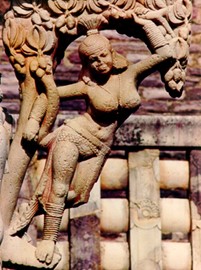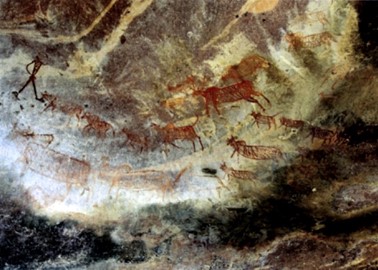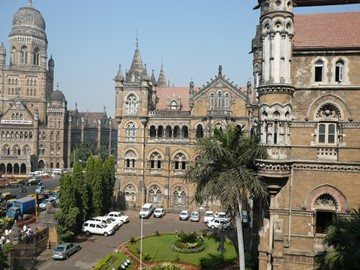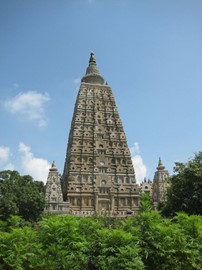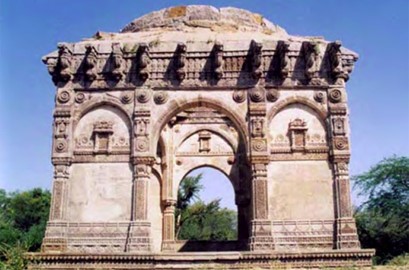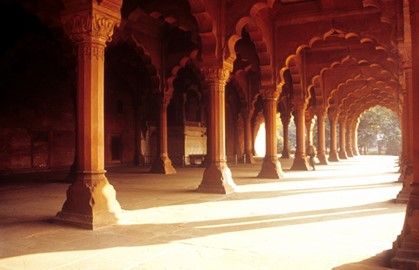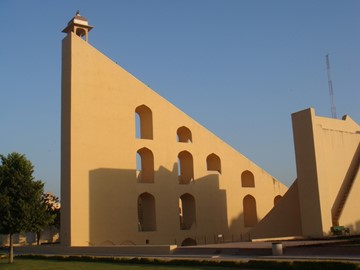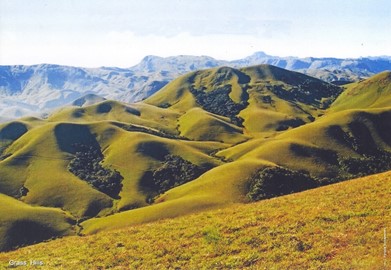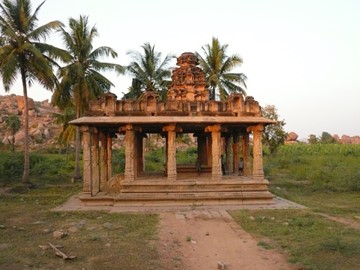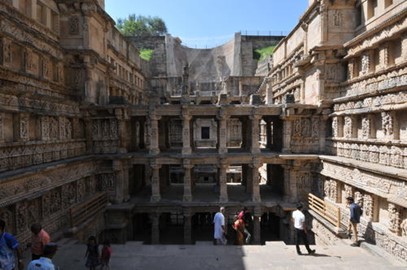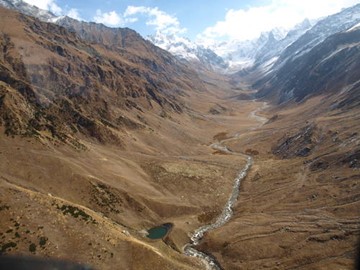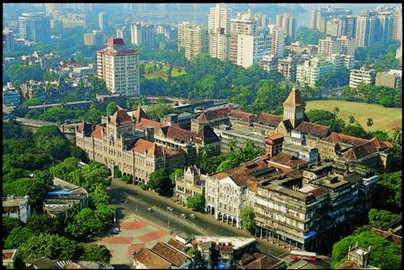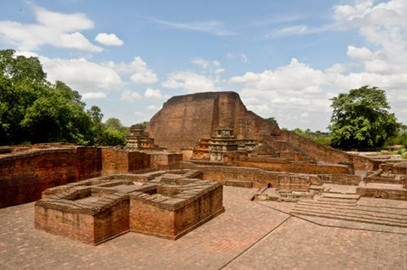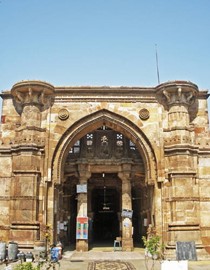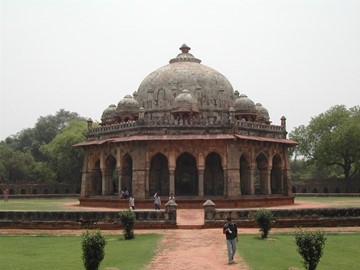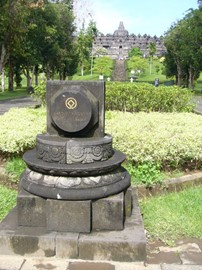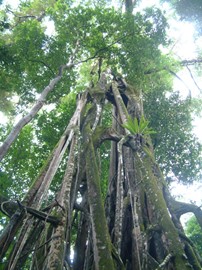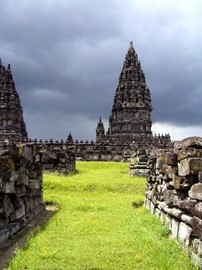region :: asia and the pacific
Sanchi
The Buddhist Monuments at Sanchi, a UNESCO World Heritage site in India, are a remarkable collection of ancient structures dating back to the 3rd century BCE. This historic complex includes intricately carved stupas, monasteries, and temples that showcase the evolution of Buddhist art and architecture. The site is renowned for its well-preserved Great Stupa, a significant pilgrimage destination that exemplifies early Buddhist monument design. These monuments collectively reflect the profound cultural and re... Read More
Rock Shelters of Bhimbetka
The Rock Shelters of Bhimbetka, a UNESCO World Heritage site in India, are a remarkable collection of prehistoric rock art and archaeological remains spanning over 100,000 years. Discovered in 1957, these natural shelters showcase paintings from the Paleolithic to medieval periods, depicting daily life, animals, and rituals of ancient inhabitants. The site offers invaluable insights into human evolution and cultural development, preserved within its rugged sandstone formations.
Chhatrapati Shivaji Terminus
Chhatrapati Shivaji Terminus, a UNESCO World Heritage site in India, is an iconic railway station renowned for its Victorian Gothic architecture blended with Indian influences. Designed by Frederick William Stevens and completed in 1888, it serves as a major transportation hub and a symbol of the country's colonial past. The structure features intricate stone carvings, pointed arches, and a grand central dome, making it a masterpiece of historical and architectural significance. Today, it stands as a testam... Read More
Mahabodhi Temple
The Mahabodhi Temple Complex, a UNESCO World Heritage site in India, is an ancient Buddhist temple renowned for its historical and spiritual significance. Built around the 3rd century BCE and later expanded, it marks the location where Gautama Buddha attained enlightenment under the Bodhi Tree. The complex features a striking 55-meter-high pyramid-shaped tower, intricate carvings, and serene courtyards, reflecting a blend of architectural styles from different periods. It remains a vital pilgrimage destinat... Read More
Champaner Pavagadh
Champaner-Pavagadh, a UNESCO World Heritage site in India, is a remarkable historical and archaeological complex showcasing a blend of Hindu and Islamic architecture. This well-preserved site features an ancient fortified city, mosques, temples, and stepwells, reflecting its rich cultural heritage from the 8th to 14th centuries. The hill of Pavagadh, crowned with a revered temple, adds spiritual significance to this unique destination, recognized for its outstanding universal value.
Red Fort
The Red Fort Complex, a UNESCO World Heritage site in India, is a historic fortress renowned for its stunning Mughal architecture and rich history. Constructed in the 17th century by Emperor Shah Jahan, it served as the main residence of Mughal emperors for nearly 200 years and later became a symbol of India's struggle for independence. The complex features impressive red sandstone walls, intricate palaces, and beautiful gardens, reflecting the grandeur and artistic mastery of the Mughal era. Today, it stan... Read More
Mountain Railways of India
The Mountain Railways of India, a UNESCO World Heritage site, showcase an impressive feat of engineering with their scenic routes through rugged terrain. Constructed between the late 19th and early 20th centuries, these railways highlight innovative solutions to challenging landscapes, blending historical significance with stunning natural beauty. They remain operational, offering a unique travel experience while preserving their cultural and technical legacy.
Jantar Mantar
Jantar Mantar, a UNESCO World Heritage site in India, is an extraordinary collection of 18th-century astronomical observatories built by Maharaja Jai Singh II. These architectural marvels, featuring large-scale instruments like sundials and celestial trackers, were designed to precisely measure time, predict eclipses, and observe planetary positions. The site showcases a brilliant fusion of science, architecture, and cultural heritage, reflecting India’s historical advancements in astronomy. Today, it stand... Read More
Western Ghats
The Western Ghats, a UNESCO World Heritage Site in India, is a biodiversity hotspot renowned for its rich flora and fauna. This mountain range, running parallel to the western coast, hosts numerous endemic species, including rare plants, animals, and birds, thriving in its diverse ecosystems like tropical rainforests and grasslands. It also plays a vital role in regulating the region's monsoon climate and supporting livelihoods through its rivers and forests. Recognized for its ecological significance, it s... Read More
Hampi
Hampi, a UNESCO World Heritage Site in India, is a captivating ancient city renowned for its historical and architectural significance. Once the thriving capital of the Vijayanagara Empire in the 14th century, it boasts an impressive array of intricately carved temples, royal pavilions, and monolithic sculptures spread across a vast landscape. The site, including the iconic Virupaksha Temple and Vittala Temple with its musical pillars, offers a glimpse into a rich past, blending natural beauty with cultural... Read More
Hill Forts of Rajasthan
The Hill Forts of Rajasthan, a UNESCO World Heritage site in India, comprise six majestic forts built between the 5th and 18th centuries by Rajput rulers. These forts, showcasing exceptional architecture and strategic design, served as centers of power, defense, and culture. Their robust walls, intricate palaces, and temples reflect a blend of Rajput and Mughal influences, offering a glimpse into India’s rich historical legacy. Today, they stand as enduring symbols of the region’s royal heritage and enginee... Read More
Rani ki Vav
Rani-ki-Vav, a UNESCO World Heritage site in India, is an intricately designed stepwell built in the 11th century as a memorial to a king by his widowed queen. Renowned for its stunning architecture, it features seven levels of stairs adorned with over 500 detailed sculptures of Hindu deities and mythological scenes. Originally constructed to provide water during dry seasons, this subterranean marvel was later restored after being buried by floods for centuries. Today, it stands as a testament to ancient en... Read More
Great Himalayan
The Great Himalayan National Park, a UNESCO World Heritage site in India, is renowned for its breathtaking biodiversity and pristine natural landscapes. This protected area harbors a rich variety of flora and fauna, including rare and endangered species, thriving amidst diverse ecosystems ranging from alpine meadows to dense forests. Its recognition by UNESCO underscores its global significance for conservation and ecological research, offering a sanctuary for wildlife and a haven for nature enthusiasts.
Victorian Gothic and Art Deco Ensembles of Mumbai
The Victorian Gothic and Art Deco Ensembles of Mumbai, a UNESCO World Heritage site in India, showcase a remarkable blend of architectural styles from the 19th and early 20th centuries. The Victorian Gothic buildings, characterized by intricate detailing, pointed arches, and ribbed vaults, reflect British colonial influences, while the Art Deco structures feature bold geometric shapes, vibrant colors, and modern aesthetics inspired by global trends. This unique fusion of designs highlights the city’s histor... Read More
Nalanda
Nalanda, a UNESCO World Heritage site in India, was an ancient center of learning that flourished from the 5th to the 13th century. This renowned Buddhist university attracted scholars from across Asia, offering studies in philosophy, mathematics, astronomy, and medicine. Its vast library, containing countless manuscripts, was a treasure trove of knowledge until its destruction in the 1190s. Today, the excavated ruins, including monasteries and stupas, stand as a testament to its historical significance and... Read More
Khangchendzonga
Khangchendzonga National Park, a UNESCO World Heritage site in India, is renowned for its stunning biodiversity and cultural significance. Nestled in the Himalayas, it boasts a rich array of flora and fauna, including rare species like the snow leopard and red panda, alongside sacred peaks like Mount Khangchendzonga, the third-highest mountain in the world. The park seamlessly blends natural beauty with the spiritual traditions of the indigenous communities, offering a unique ecological and cultural treasur... Read More
Ahmedabad
The Historic City of Ahmedabad, a UNESCO World Heritage site in India, is renowned for its rich architectural legacy and cultural significance. Founded in the 15th century, it showcases a blend of Hindu, Islamic, and Jain influences through its intricately carved monuments, mosques, and traditional wooden havelis. The city's centuries-old walled structure and vibrant bazaars highlight its historical role as a thriving trade center. Its designation reflects its outstanding universal value as a testament to I... Read More
Humayun's Tomb
Humayun's Tomb, a UNESCO World Heritage site in Delhi, India, is an architectural marvel commissioned in 1565 by Empress Bega Begum for her husband, Emperor Humayun. This grand mausoleum, built from red sandstone and white marble, showcases Mughal design with its symmetrical layout, arched entrances, and Persian-style charbagh garden. It served as an inspiration for later monuments, including the Taj Mahal, and stands as a testament to the dynasty's cultural and artistic legacy. Today, it remains a signific... Read More
Borobudur
Borobudur, a UNESCO World Heritage site in Indonesia, is a magnificent 9th-century Buddhist temple renowned for its intricate design and historical significance. Constructed with over two million stone blocks, this architectural marvel features a massive stupa at its summit, surrounded by 72 smaller stupas and more than 500 Buddha statues. The temple’s walls are adorned with detailed reliefs depicting Buddhist teachings, making it a vital cultural and spiritual landmark. Today, it stands as one of the world... Read More
Sangiran Early Man Site
The Sangiran Early Man Site, a UNESCO World Heritage site in Indonesia, is a critical archaeological location renowned for its significant fossil finds, including some of the earliest evidence of human ancestors in Southeast Asia. Discovered in the 1930s, the site has yielded numerous Homo erectus remains, stone tools, and animal fossils, offering valuable insights into human evolution over a span of more than 1.5 million years. Its global importance lies in its contribution to understanding the development... Read More
Ujung Kulon
Ujung Kulon National Park, a UNESCO World Heritage site in Indonesia, is a biodiverse sanctuary renowned for its lush rainforests, pristine beaches, and rare wildlife. It serves as the last refuge for the critically endangered Javan rhino, alongside other species like leopards, gibbons, and sea turtles. The park’s volcanic landscape, including the iconic Krakatau island, adds to its ecological and historical significance. Conservation efforts here focus on protecting its unique ecosystem and promoting susta... Read More
Komodo
Komodo National Park, a UNESCO World Heritage site in Indonesia, is renowned for its unique biodiversity, most notably as the habitat of the Komodo dragon, the world’s largest lizard. Established in 1980, the park encompasses a group of volcanic islands with rugged terrain, pristine beaches, and vibrant coral reefs, supporting a rich array of marine and terrestrial species. It serves as a critical conservation area, protecting endangered wildlife and offering visitors a glimpse into a prehistoric ecosystem.... Read More
Prambanan
Prambanan Temple, a UNESCO World Heritage site, is a stunning 9th-century Hindu temple complex renowned for its intricate stone carvings and towering architecture. Dedicated primarily to the Trimurti—Brahma, Vishnu, and Shiva—it showcases Indonesia's rich cultural and religious history. The temple’s detailed reliefs depict scenes from the Ramayana, offering insight into ancient artistry and storytelling. Restored after centuries of neglect and natural disasters, it stands as a testament to human ingenuity a... Read More
Lorentz
Lorentz National Park, a UNESCO World Heritage site in Indonesia, is renowned for its exceptional biodiversity and stunning landscapes. This protected area encompasses a range of ecosystems, from coastal mangroves to alpine peaks, harboring rare species like the long-beaked echidna and the southern cassowary. It also holds significant cultural value, with indigenous communities maintaining traditional lifestyles amidst its vast wilderness. The park stands as a critical conservation zone, showcasing Indonesi... Read More
Sumatra Tropical Rainforest
The Sumatra Tropical Rainforest, a UNESCO World Heritage site in Indonesia, is renowned for its rich biodiversity and ancient ecosystems. This protected region is home to rare species like the Sumatran orangutan, tiger, and rhinoceros, thriving within its lush, dense forests. Its global significance lies in its role as a critical conservation area, preserving unique flora and fauna for scientific study and environmental balance.
